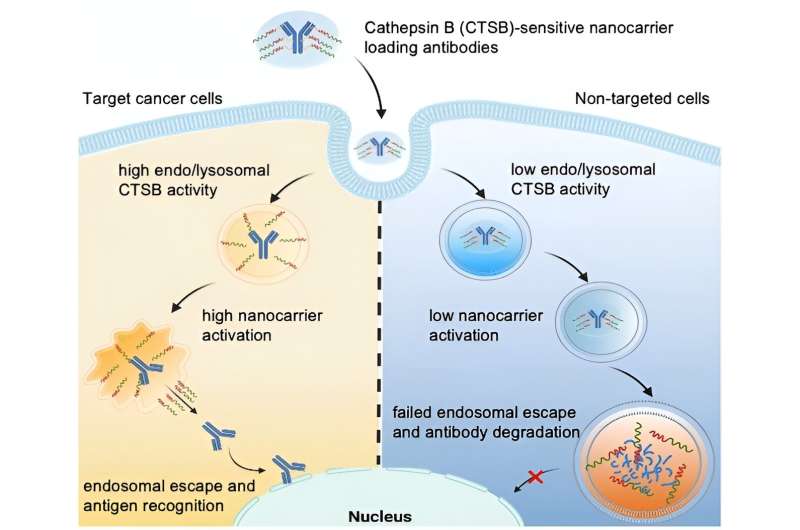Credit: Angewandte Chemie International Edition (2024). DOI: 10.1002/anie.202317817
Protein-based drugs must be transported into cells in a way that prevents their immediate degradation. A new approach is intended to ensure that they remain intact only in certain cells, such as cancer cells. In a study published in the journal Angewandte Chemie International Edition, a Japanese research team has introduced a nanocarrier that can "escape" from endosomes before its cargo is destroyed there. This ability to escape is only triggered within the endosomes of certain tumor cells.
The uptake of nanocarriers into cells occurs by endocytosis: When a nanocarrier lands on the cell surface, the cell membrane folds in and encloses it in a bubble, called an endosome, which then drifts into the cell interior. In its late phase, the endosome merges with lysosomes that contain enzymes, forming an endolysosome. Within this structure, the enzymes break down both material from the body and foreign material.
A protein-based drug can only become active if it "escapes" the endolysosome before being broken down. This is known as "endosomal escape." Some nanocarriers can open the endo/lysosomal membrane and thus have endosomal escape ability.
Led by Kazunori Kataoka and Horacio Cabral, the team aims to take this a step further by producing nanocarriers for which endosomal escape is only triggered when they enter very specific cells, such as tumor cells. This would protect healthy cells. The researchers exploit the fact that different types of cells have very different endolysosomal enzyme activities. For example, the activity of the protease cathepsin B (CTSB) is especially high in cancer cells.
With the use of special fluorescence probe molecules, the team from The University of Tokyo and the Kawasaki Institute of Industrial Promotion initially studied CTSB activity and protein degradation in endosomes. They determined that in cancer cells with highly acidic endosomes, CTSB activity is already very high in their early phase—significantly before protein degradation ramps up. The researchers take advantage of this time window by using nanocarriers whose endosomal escape ability is triggered by the CTSB in cancer cells.
The team constructed poly(ethylene glycol)-based nanocarriers with diaminoethane groups capable of "tearing open" endo/lysosomal membranes. Using a linker, they then attached antibodies to act as a model for a protein drug. The nanocarrier shields the "tearing tools" so that they are initially inactive.
The linker is designed to be split by the CTSB in the endolysosomes. This separates the cargo from the carrier, activating the tearing tools. They open the endo/lysosomal membrane and release intact antibodies into the cell interior—but only in tumor cells that have elevated endosomal CTSB activity.
This method could represent a new strategy for the cell-specific release of drugs through stimulus-responsive nanocarriers with controlled endosomal escape.
More information: Pengwen Chen et al, Selective Intracellular Delivery of Antibodies in Cancer Cells with Nanocarriers Sensing Endo/Lysosomal Enzymatic Activity, Angewandte Chemie International Edition (2024). DOI: 10.1002/anie.202317817
Journal information: Angewandte Chemie International Edition
Provided by Wiley
























